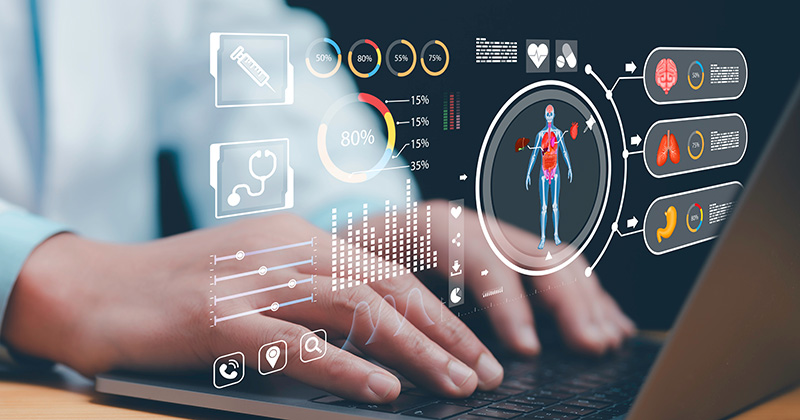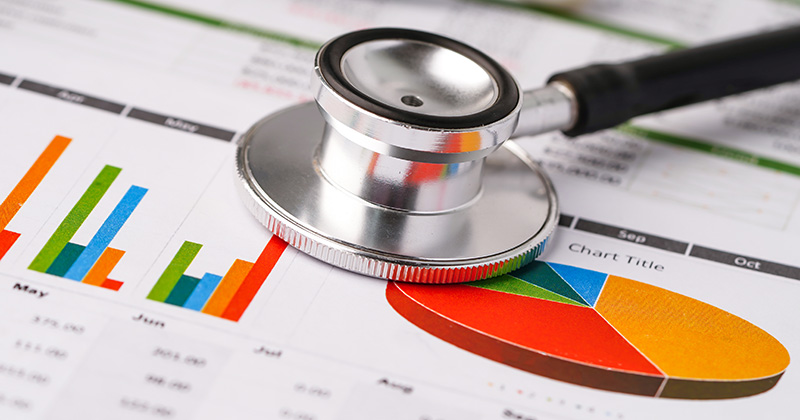Leveraging Healthcare Data Analytics for Improved Clinical Performance

Your practice collects data—a lot of it. That’s a start, but it’s what you do with your data that really counts.
With the right strategy and tools, your data can become your most powerful asset. It can inform your decision-making, fuel your growth, and improve patient outcomes.
Ready to get started? This is your complete guide to data analytics in healthcare.
We’ll give you the basics before exploring the types of healthcare data analytics. And we’ll show you exactly how you can use data to improve patient care.
We’ll also share practical strategies for training your staff. Finally, we’ll wrap up with steps you can take to leverage healthcare data analytics.
Numbers don’t lie. Use this to your advantage, and give your patients the exceptional experience they deserve.
RELATED ARTICLE: How Big Data is Changing Medicine
Understanding Data Analytics in Healthcare
Data analytics is about examining raw data to draw conclusions.
Here’s how the process unfolds step-by-step:
- Data is collected from various sources. This might include electronic health records (EHRs), patient surveys, and billing information.
- Errors or inconsistencies in the data are removed or corrected to ensure integrity and accuracy.
- Software is used to analyze the cleaned data. Statistical methods and algorithms identify patterns and trends.
- The results of the analysis are interpreted and translated into actionable insights to inform decision-making.
- The findings are presented in an easy-to-understand format.
How Data Analytics Affects Healthcare
Data analytics is changing healthcare. It’s becoming an essential part of operations.
You can use it to track patient health trends. For example, data can show how many people get the flu each year. This helps your staff better prepare for what’s to come.
Analytics also helps in making treatment plans. Each patient is different. Data can help find the best treatment for each person. This means better results and fewer side effects.
Data analytics in healthcare can improve operations too. For example, it can help reduce wait times by making sure there are enough doctors and nurses on duty during peak times.
In the future, data analytics will prove even more valuable.
Doctors will be able to diagnose diseases earlier. This means treatment can start sooner, which typically leads to more positive outcomes. In short, it can save lives.
Examples of Data Analytics in Healthcare
Let’s illustrate the sheer power of data analytics in healthcare with a couple of examples.
Say you have a patient with a chronic disease like diabetes. Analytics tools use historical patient data to forecast potential complications. It looks at factors like:
- Blood sugar levels
- Medication adherence
- Lifestyle choices
Then, it predicts whether that patient is at a high risk of adverse events. You can then introduce early interventions to help mitigate these risks.
Here’s another example, this time in the emergency department.
Data analytics can predict patient influx based on what’s happened in the past. It can also consider things like weather, holidays, and local events.
You can use this insight to allocate staff and manage resources. Your department is well-prepared for peak times.
Patients are seen faster, and this improves their experience and health outcomes.
RELATED ARTICLE: Using Technology for Streamlined Revenue Cycle Management - A Guide for Healthcare Practices

Types of Healthcare Data Analytics
There are different types of data analytics you can use to achieve different goals. Each type has a distinct purpose.
Familiarize yourself with each one so you can better leverage analytics in your practice.
Descriptive Analytics
Descriptive analytics looks at past data to understand what happened. It summarizes historical data to show trends and patterns.
- Purpose: To understand past performance and identify trends
- Example: Analyzing patient admission rates over the past year to identify seasonal trends
Predictive Analytics
Predictive analytics uses historical data to predict future outcomes. It identifies patterns that forecast future events.
- Purpose: To anticipate future events and prepare accordingly
- Example: Predicting which patients are at high risk of readmission based on their medical history
Prescriptive Analytics
Prescriptive analytics suggests actions based on data. It uses algorithms to recommend steps to achieve desired outcomes.
- Purpose: To guide decision-making and optimize outcomes
- Example: Recommending the best treatment plan for a patient based on their medical history and current condition
Discovery Analytics
Discovery analytics explores data to find new patterns and relationships. It’s often used in research to uncover new insights.
- Purpose: To identify unknown patterns and generate new knowledge
- Example: Discovering a correlation between a certain medication and improved patient outcomes through exploratory data analysis
FROM ONE OF OUR PARTNERS: 4 Billing Analytics Tools that Providers Need

How Data Analytics Improve Patient Care
Every practice is unique. But if there’s one thing all healthcare professionals have in common, it’s their passion for patient care.
“Patient care” is a term that encompasses all the services provided that aim to improve health outcomes.
Exceptional patient care is critical for obvious reasons—it’s what every person is entitled to and deserves. But in addition to this, it’s a key ingredient in the financial success of your practice.
When patients are satisfied with your services, they stay loyal. They recommend your practice to others. This increases revenue and drives growth.
In addition, better patient outcomes also mean fewer readmissions and lower costs.
According to one study:
“Patient centered care requires that health care organizations and health care professionals actively understand what patients value. Fortunately, there are methods for gaining that understanding."
One method is data analytics. You can use insights to make smart decisions based on evidence, not assumptions. These decisions improve patient care.
Want to know how? Here are some specific ways:
Identify High-Risk Patients
Data analytics can suggest which patients are at a high risk of chronic diseases or complications.
For example, healthcare technology like DrChrono makes it simple to log patient’s vitals at each visit. This gives you a record of each patient’s historical vitals data. From this, you can analyze their data for health concerns.
When you know who is at risk, you can provide targeted care. This prevents serious health issues and reduces hospital readmissions.
Provide Personalized Treatment Plans
Every patient is an individual. Data analytics allow you to create truly customized treatment plans.
You can use patient data to build treatment protocols that meet unique needs. This increases the likelihood of a good outcome.
For example, data from wearable devices can monitor a patient’s condition in real time. Looking at this data, you can adjust treatment approaches.
Improve Medication Management
Medication errors can be dangerous and costly. Data analytics can track and manage prescriptions for you.
Tools like EHRs examine patient data to check for correct dosages. They also help you avoid harmful interactions.
This locks in patient safety and mitigates the risk of adverse drug events.
Enable Preventive Care
Prevention is better than a cure. Data analytics identifies trends and risk factors, allowing for early intervention.
For example, analytics can highlight patients who need vaccinations or screenings. Patients can take action early, which may reduce the incidence of serious illnesses.
Ensure Shorter Wait Times
Long wait times frustrate patients and can lead to dissatisfaction. Data analytics help manage appointment scheduling and patient flow.
Software can look at patterns in patient visits. Using this information, you can optimize staff scheduling.
Deliver Greater Patient Satisfaction
Patient satisfaction is a strong indicator of care quality.
Data analytics tools can track and analyze feedback from patient surveys. This helps you understand patient needs and concerns.
You can then make changes to your workflows to address any issues raised. This continuous process of improvement boosts patient satisfaction. Satisfied patients are more likely to stay loyal to your practice and spread the word to friends and family.
Optimize Resource Allocation
Data analytics in healthcare show you how resources are used and where there are inefficiencies.
For instance, you can investigate the usage of medical supplies and equipment. This data helps you predict demand and avoid shortages or excess inventory.
FROM ONE OF OUR PARTNERS: 3 Ways Denial Analytics Improves Healthcare Organizations

Training Your Healthcare Staff to Use Data Analytics
Without proper training, your staff may misuse data or overlook valuable insights. This can lead to poor patient outcomes and inefficiencies in your practice.
In contrast, high-quality, accessible training ensures your team understands how to collect, analyze, and use data. It maximizes the benefits of your data analytics tools.
Here are our top tips:
Start with the Basics
Begin with basic training sessions. Explain what data analytics is and why it matters. Show how data analytics can improve patient care and streamline operations.
Use real-life examples from your practice. This helps staff understand the relevance and importance of data analytics.
Offer Hands-On Training
Provide hands-on training with the actual data analytics tools your practice uses.
For example, if you use DrChrono, have staff practice with its features. Let them explore the software and perform tasks they will do in their daily roles.
Schedule Regular Refreshers
Data analytics tools and practices evolve.
Offer regular updates and refresher courses. This keeps your staff updated with new features.
Connect Data to Patient Care
Help your staff see the connection between data and patient care. Connect the dots so they can see exactly how data can lead to better diagnoses, treatments, and patient outcomes.
Use specific cases from your practice where data analytics made a difference. This motivates staff by highlighting the real impact of their work.
Encourage Team Collaboration
According to Cornell University’s Center for Teaching Innovation, “educational experiences that are active, social, contextual, engaging, and student-owned lead to deeper learning.”
So, encourage your staff to work together and share insights. Create a culture of collaboration around data analytics.
Have regular meetings where staff can discuss data findings and how they applied them. This promotes continuous learning and improvement. It also makes sure everyone is on the same page.
First Steps to Leveraging Healthcare Data Analytics
Ready to introduce data analytics into your healthcare practice? Here are some steps to take to get started:
- Review your current data collection processes. Look at what data you’re already collecting. Flag gaps where data is missing or inconsistent.
- Assess data quality. Check the accuracy and completeness of your data. Entries should be correct and up-to-date. Verify that data is entered in a standardized format to avoid confusion.
- Identify areas that need improving. Highlight areas where data analytics can make a meaningful difference. Focus on the specifics, like patient flow, treatment efficiency, and resource management. Prioritize areas with the most potential for improvement.
- Invest in analytics software. Research and choose a user-friendly data analytics tool. Look for features like real-time reporting and predictive analytics.